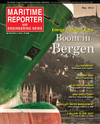
Page 32: of Maritime Reporter Magazine (May 2013)
Energy Production & Transportation
Read this page in Pdf, Flash or Html5 edition of May 2013 Maritime Reporter Magazine
32 Maritime Reporter & Engineering News ? MAY 2013 Rain, mountains and fjords: The three things that spring most read-ily to mind when the name Bergen is mentioned. The city of around 270,000 people ? Norway?s capital in the 13th century ? is a dramatic, beautiful and, yes, very wet place. Its brightly colored buildings sit scattered between and up the sides of the seven mountains that encircle the metropolitan area. Its UNESCO World Heritage listed harbor area bustles with activity, from snap happy tourists to time poor traders, before everything melts out into the cold and crystal waters that slide se-renely into the North Sea. Its people are proud, but friendly, its beer is ex- pensive, but worth it, and its puddles are, well, everywhere.Such are the impressions of Ber- gen. It?s a striking and memorable place. But not always for the right reasons, argues Øystein Meland, the Managing Director of Bergen Ship- owners? Association. Meland appreciates that the obvi-ous natural beauty may catch the imagination and the headlines, but he believes it?s the industrial heritage, abundance of talent and on-going maritime opportunities that should really be making waves.The quiet over-achiever Meland?s organization, along with seven other local partners, is lead-ing the Maritime Bergen initiative, a campaign aiming to bring the strength of the regional industry to a global audience. Together the partners com- missioned economic research outÞ t Menon in 2012 to map the maritime sector in the wider Bergen region. The results of this study, published in a special report this year, make capti- vating reading.According to Menon?s Þ ndings, the local maritime cluster employs a total of 20,184 people and produces a turnover of NOK 80 billion ($13.9 billion). In terms of ?wealth creation? for the region ? a measure worked out by adding the operating proÞ ts of the companies to the wages of the in-dividuals that they employ ? the clus-ter generated NOK 27 billion ($4.7 billion) for the local area. Bergen is the largest port for handling oil cargo volumes in the entire Nordic region, and Norway?s largest for cruise ship calls (with 338 scheduled for 2013) and domestic and international cargo. In addition to this, Bergen eas- ily outshines its ?big brother? Oslo, more globally renowned as a ship-ping centre, in terms of its overall ß eet. Bergen has 510 vessels sailing with a Norwegian ß ag (compared to 240 in Ålesund and ?only? 180 in Oslo) and 530 registered in foreign territories (all above 100 gross tons).All this and people still focus on the leaky clouds. It can be, Meland imparts, more than a little frustrating.?We have good reason to con Þ -dently say that Bergen has the most complete, strongest and well-devel-oped maritime cluster in Norway,? he says, adding that the city region is awash with ?genuinely world class companies? with ?long traditions of innovation, customer focus and ex-cellent ß eet organisation and man- agement.? On this last note he points to nu-merous examples to prove his, and his partners? case. Discover NorwayBERGENBergenA Unique Maritime Environment The weather might be depressing, but the outlook for the city is anything but. Bergen?s ship- ping industry and maritime related ser- vices sectors are going from strength to strength, bullishly rebutting the worst of the waves caused by the ongoing global Þ nancial crisis. The secret, locals argue, is a long-term industry view, the strength and diversity of the maritime cluster and the fact that Bergen blood is very much thicker than water. Maritime Reporter goes native to investigate.By Alan Johnstone Images Courtesy David Zadig/www.brb.no MR #5 (26-33).indd 32MR #5 (26-33).indd 325/2/2013 9:28:24 AM5/2/2013 9:28:24 AM

 31
31

 33
33
